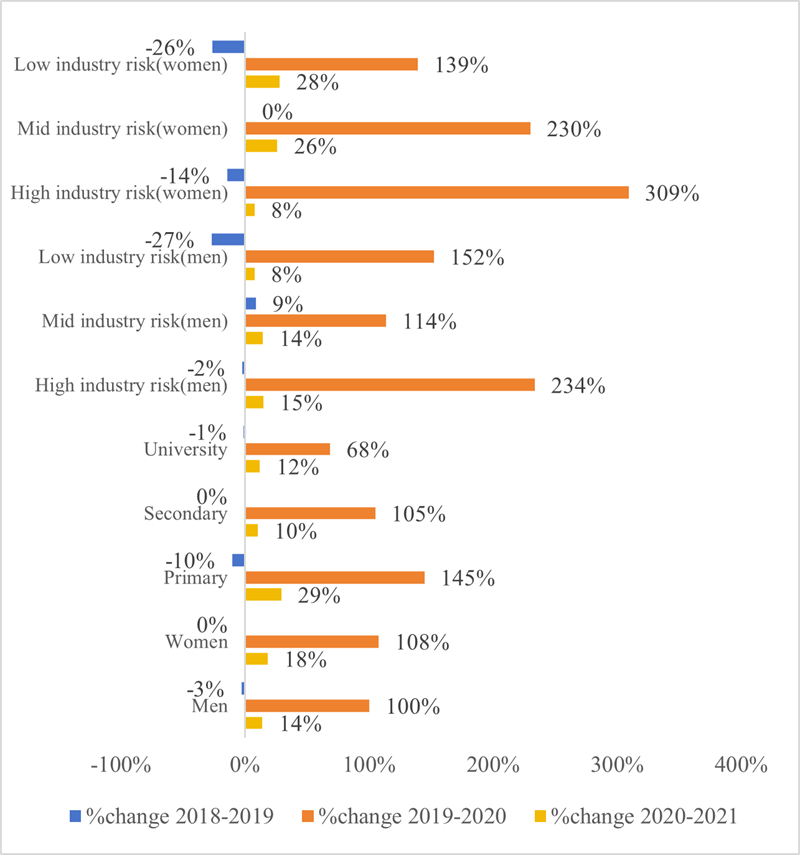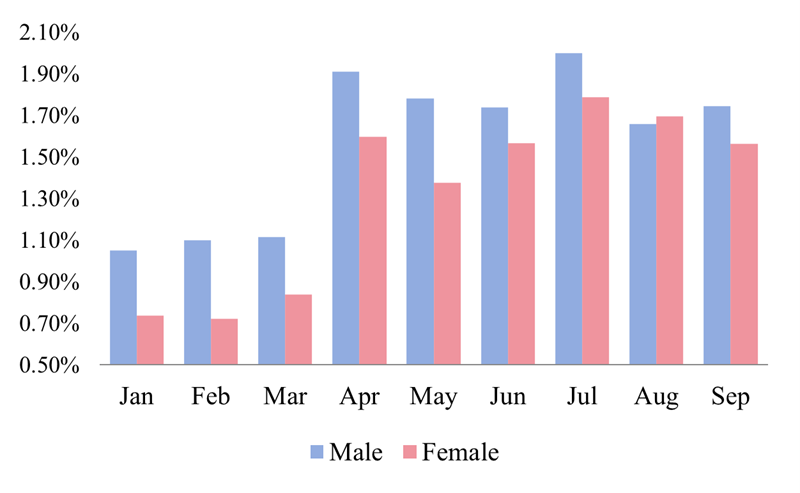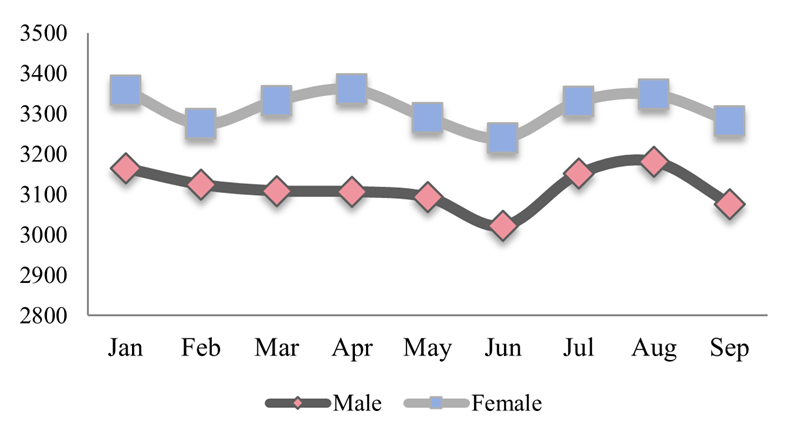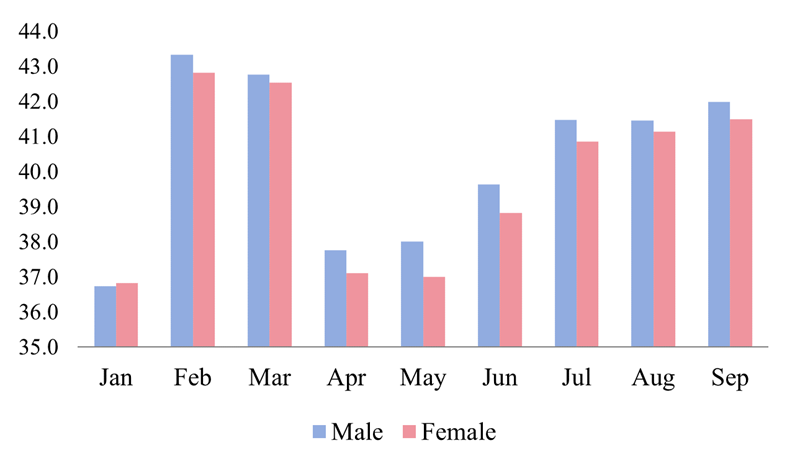IDE Research Columns
Column
Who Suffers the Most during the COVID-19 Pandemic? Evidence from Thailand

Sasiwimon Warunsiri PAWEENAWAT and Lusi Liao
Faculty of Economics, Thammasat University, Thailand;
School of Economics and Management, Baoshan University, China
March 2025
The global labor market was significantly disrupted by COVID-19, and this study examines the impact on Thailand using Labor Force Survey data from 2018 to 2021. The workers most adversely affected are those (1) employed in high-risk sectors, (2) with lower levels of education, and (3) in younger age groups. The findings indicate that the unemployment rate is positively associated with sectoral risk levels and marital status, where married individuals and public sector employees are less likely to be unemployed. Additionally, parenthood has been linked to lower wages, with a more pronounced effect on women, suggesting a “she-cession” in the nation.
Background and Motivation
Empirical research on the labor market disruptions caused by COVID-19 has expanded in recent years, with most studies confirming its negative effects on employment outcomes, including rising unemployment, reduced working hours, and shifts in working arrangements (Brodeur et al. 2020). Moreover, the pandemic’s impact has been uneven across demographic groups, varying by sex, race, age, education level, industry, and occupation (Adams-Prassl et al. 2020). For instance, labor market disruptions have been more severe in sectors with high COVID-19 risk exposure and occupations with limited work-from-home flexibility (ILO 2020).
Thailand presents a particularly compelling case for examining the impact on labor market outcomes because its high dependence on trade and tourism has intensified the economic shock, exacerbating existing vulnerabilities (World Bank 2020). A previous study by Paweenawat and Liao (2023) that used 2018–19 data found that different demographic groups were disproportionately affected by the pandemic. Additionally, research by the ILO (2020) indicated that a higher proportion of females work in high-risk sectors compared with men. This study extends the work of Paweenawat and Liao (2023) by incorporating data from the postpandemic period and including additional variables.
Data and Methodology
This study relies on data from the nationally representative Labor Force Survey (LFS) conducted by Thailand’s National Statistical Office. We use LFS data from the third quarter of 2018, 2019, 2020, and 2021 to enable yearly comparisons in both descriptive and empirical analyses. The sample is restricted to labor force participants aged 18–60 years and includes information on employment status, industry and occupation codes, and various individual characteristics, such as age, sex, household composition, region, education level, marital status, work status, and residence area. The number of children with detailed age groups that Paweenawat and Liao (2023) do not account for is included. The analysis focuses on full-time employees (i.e., those working more than 35 hours per week) and their self-reported weekly wages from the survey.
Sectoral risk levels are classified into three categories based on the ILO’s risk assessment for employment. High-risk sectors in Thailand include retail trade, transport, accommodation, travel, related activities, and sports, and the classifications align with reports from the National Economic and Social Development Council, which demonstrate the varied effects of COVID-19 on different industrial sectors (NESDC 2020).
Our study first provides a descriptive review of how COVID-19 has affected different segments of the workforce, followed by an empirical analysis of the factors influencing employment and wages during the pandemic. We estimate regressions using cross-sectional models to assess the relationships between unemployment, wages, sector-level risk exposure, and occupational flexibility in response to COVID-19.Impact of COVID-19 on Thai Labor Market
Unlike typical economic recessions, COVID-19 simultaneously disrupted aggregate demand, supply chains, and financial markets through social distancing and lockdown measures (Mohapatra 2021). In 2020, Thailand’s gross domestic product contracted by 6.1% before rebounding with a 1.5% expansion in 2021.
Figure 1 illustrates changes in the unemployment rate across the prepandemic, pandemic, and postpandemic periods for various demographic groups. As shown, unemployment increased significantly for all groups during the pandemic in 2020 but showed notable improvement in 2021, coinciding with economic recovery and the easing of social restrictions. The rise in unemployment was more pronounced for females than for males between 2019 and 2020, whereas highly educated workers were less affected. These findings align with those of Lee, Park, and Shin (2021), who found that the pandemic had a disproportionately severe impact on females and less-educated workers in the United States.

Figure 1. Unemployment Rate Change: LFS 2018–19 vs. 2019–20 vs. 2020–21
Note: This figure shows the change in the unemployment rate in the prepandemic (2018–19), pandemic (2019–20), and postpandemic (2020–21) periods for different demographic categories. The percentage change in unemployment rates was computed from third-quarter data from LFS from years 2018, 2019, and 2020. Overall, unemployment has risen significantly for all groups.
The Thai government announced a state of emergency and restricted international and domestic mobility on March 25, 2020. Policies aimed at flattening the infection curve, including lockdowns and social distancing measures, were relatively successful in containing the outbreak. Restrictions were gradually lifted, beginning with the first phase on May 3, 2020. By July 2020, all schools, restaurants, and entertainment venues had reopened, and domestic travel had returned to normal.
Figure 2 illustrates how lockdown and social distancing measures contributed to rising unemployment and declining wages and working hours after March 2020, when the state of emergency was declared. As restrictions eased and the domestic economy began reopening, wages and working hours gradually began to recover beginning in June 2020.

(A) Unemployment Rate (%)

(B) Wage (baht)

(C) Working Hours
Figure 2. Labor Market Change from LFS January to September 2020 by Gender
Note: This figure presents the monthly unemployment rate, wage, and working hours during the pandemic. Representations were compiled using third-quarter data from Thailand’s Labor Force Survey (LFS) from years 2018, 2019, and 2020.
To assess the varying effects of COVID-19 across demographic categories, we conducted an empirical analysis using cross-sectional regression models on unemployment and wages. The results indicate that individuals working in high-risk sectors and jobs with limited work-from-home flexibility, as well as those with lower levels of education, were more negatively affected by the crisis. Females experienced higher unemployment rates than men. Regarding wages, both males and females in high-risk sectors faced the most significant wage declines, along with less-educated workers. Additionally, all demographic groups experienced a substantial reduction in working hours in 2020.
Policy Implications
Our study found that the impact of COVID-19 varied across different demographic groups. However, the Thai government’s response package for labor market disruptions caused by the pandemic has primarily targeted vulnerable populations (World Bank 2020). Our findings, however, indicate that females, high-risk sectors, and less-educated groups require greater attention from policymakers. This disproportionate impact suggests that, in the future, the government should tailor policy responses to specifically support the groups most affected by the crisis.
Author's Note
This column is based on Paweenawat, S.W. and L. Liao. 2024.“Who Suffers the Most during the COVID-19 Pandemic? Evidence from Thailand.” The Developing Economies 62(3), September: 238–268. https://doi.org/10.1111/deve.12400
References
Ministry of Public Health, Thailand. 2020. “Corona Virus Disease (COVID-19).” https://ddc.moph.go.th/viralpneumonia/eng/index.php
WHO (World Health Organization). 2020. COVID-19 Health System Response Monitor: Thailand. New Delhi: World Health Organization. https://apps.who.int/iris/handle/10665/334146
* Thumbnail image: Coronavirus test - Medical worker taking a throat swab for coronavirus sample from a potentially infected woman (PonyWang / Getty Images)
** The views expressed in the columns are those of the author(s) and do not represent the views of IDE or the institutions to which the authors are attached.

